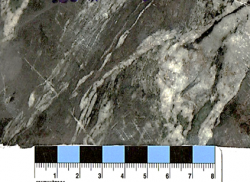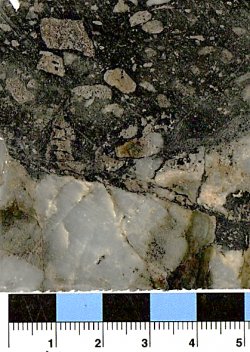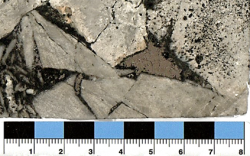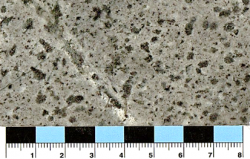VANCOUVER, BRITISH COLUMBIA, December 1, 2020 -- SALAZAR RESOURCES LIMITED (TSXV: SRL) (Frankfurt: CCG.F) (“Salazar” or the "Company") is pleased to provide an update on its wholly owned Los Osos project, held by Minera del Valle S.A, a 100% owned subsidiary of Salazar Resources. OSO-01, the first diamond drill hole at Los Osos, has been completed at a depth of 647 m with 0.5-5.0% mixed sulphide mineralization visible from 63 m to the end of hole across all of the main three lithologies, namely metamorphic host rock, hydrothermal breccias and porphyry diorite intrusions. OSO-01 bottomed in sulphide mineralization. The sulphide mineral assemblages and alteration patterns indicate that the hole has intersected the upper portions of a newly identified alkalic Au-Cu porphyry system. OSO-02, underway, is targeting the lower portions of the system and intersected a porphyry diorite with stockwork veining at a depth of 75 m. The hole is currently at a depth of 400 m and still in mineralized porphyry diorite.
Highlights
- Continuous mineralization; complex breccias and porphyry diorites with stockwork veining; k-feldspar alteration, widespread silicification, minor retrograde phyllic alteration
- Strong sulphide content 0.5 – 5.0% visible over 584 m, presenting as widely disseminated sulphides across all rock-types, frequently as veinlets and clast replacement, and occasionally as sulphide veins up to 2 cm in thickness. The mineral assemblage comprises pyrite, chalcopyrite, pyrrhotite, and arsenopyrite with lesser sphalerite and molybdenite. There are multiple phases of mineralization. Only the top, weathered 63 m contained no visible sulphides, although iron-staining of the oxidised material suggests mineralization from surface
- Quartz-tourmaline hydrothermal breccias are the dominant lithology with sulphide mineralization in clasts and in the matrix, and individual intersections of up to 110 m in length. Some mineralized crackle breccias are present. Numerous thin pebble dikes cross-cut breccias and porphyry intrusions. The pebble dikes intersected in this hole are all mineralized, often with a sulphide-rich matrix and carrying clasts rich in chalcopyrite from greater depths in the system
- Diorite porphyries with disseminated and locally intense stockwork veining and sulphide mineralization are present, reaching a maximum intersection length of 20 m, indicative of a deeper porphyry intrusion
- These geological features are strongly associated with gold mineralization in the Cangrejos-Zaruma trend. Further, the 17 million ounce (“Moz”) Cangrejos deposit is hosted in quartz-tourmaline hydrothermal breccias and silicified porphyries
Francisco Soria, Manager of Exploration and Geology said: "The first drill hole has intersected a large amount of sulphide in the core over extended intervals, with dynamic breccias, multiple phases of mineralisation and intense alteration. OSO-01 confirms that Los Osos contains a significant system, and it validates the mapping and sampling techniques used by the team to plan drill holes. In particular we are excited about the indications of mineralisation continuing at depth such as the sulphide-rich pebble dikes and the chalcopyrite-rich stockwork veining in the porphyritic diorite.
We interpret the presence of chalcopyrite, arsenopyrite and pyrrhotite alongside pyrite as a good fertility indicator of the system. We look forward to getting results back from OSO-01 and we are encouraged by the geology already being intersected on OSO-02. The second hole is targeting a mineralized porphyry diorite intrusion at an elevation approximately 300 m below the collar location of OSO-01.
Fredy E. Salazar, CEO, commented: “Osos is the first 100% project that Salazar Resources has drilled since 2017, and it is hugely exciting to see mineralisation from surface in the first two holes, and to define a new gold-copper porphyry system. Success at OSO-01 and OSO-02 underlines our credentials as a proven exploration company, and our ability to make fresh discoveries.
With geophysics ongoing at our Macara Mina VMS project too, we are making solid progress in line with our strategy to discover deposits and create value through exploration in Ecuador.”
Los Osos
Background
The 5,000 m Phase 1 drilling program at the Osos project, El Oro, Ecuador, is designed to define mineralized breccias and test for the presence of the upper portions of a mineralized porphyry.
The property is located in the Miocene Porphyry belt of Ecuador which is becoming an increasingly important zone of discoveries. It sits at the western end of the Cangrejos Zaruma intrusive belt in southern Ecuador. This geologic belt is typified by multiple nested late Oligocene to Early Miocene intrusions, punctured and intruded by a number of porphyry dikes and breccia pipes The approximately 20 Ma age of the intrusions in the Zaruma intrusive belt is the same as that of the giant Chilean porphyries which range in age from 10-40 Ma years(1).
Figure 1. Regional Geology of the Cangrejos-Zaruma intrusive belt, El Oro, Ecuador

Source: Salazar Resources
On a more local scale Los Osos lies on the southwestern edge of an interpreted collapsed caldera which is a broadly circular feature. The district is associated with copper and gold mineralization found in quartz-tourmaline breccias and stockwork porphyritic diorite intrusions, of which the best known is the Cangrejos deposit held by Lumina Gold Corporation (“Lumina Gold”) which is situated on the northern edge of the caldera.
Sampling work to date at Los Osos shows a relationship between sulphide content and gold content, with better grades where sulphide mineralization is more intense. The geology, mineralization and alteration in terms of style, size and geometry are consistent with the surface exposure of a vertically extensive, well-preserved hydrothermal-breccia and porphyry gold-(copper) system at Los Osos (Salazar website).
Figure 2. Location of Osos-1 concession, Los Osos project, El Oro, Ecuador
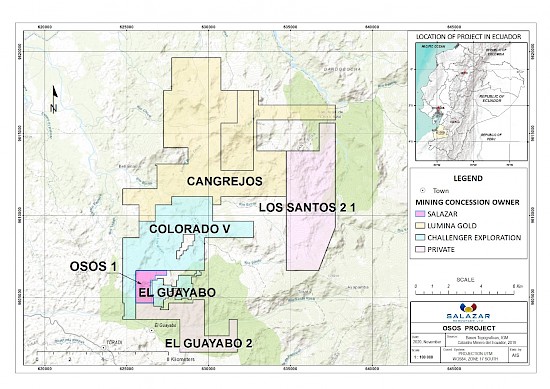
Source: Salazar Resources
OSO-01 is the first diamond drillhole on the Los Osos project. The hole is collared in metamorphic host rock and oriented 140o to the southeast below artisanal workings (also in the breccias), and coincident copper and gold geochemical anomalies. The hole was planned to be 500 m inclined at -60o to reach a depth of 433 m below surface, and to traverse 250 m horizontally. Given that OSO-01 has intersected consistently mineralized lithologies, the hole continued to the limit of the capabilities of the drill rig at 647 m. https://www.salazarresources.com/projects/100-salazar-owned/los-osos/
Although the region, and surface work, show a correlation between the amount of sulphide in the rock and gold, when it comes to gold, assays are always required before grade can be ascribed to geology. The mineralization seen in OSO-01 is highly encouraging, yet the observations are of a preliminary nature. The visual mineralization observed has not yet been assayed, and the intensity of visual mineralization cannot be used to estimate grade at this stage.
Geology, Alteration, and Mineralization
The principal lithologies intersected in drilling, and identified from mapping, are breccias, porphyritic diorite intrusions and metamorphic host rocks.
Figure 3. OSO-01 schematic cross-section
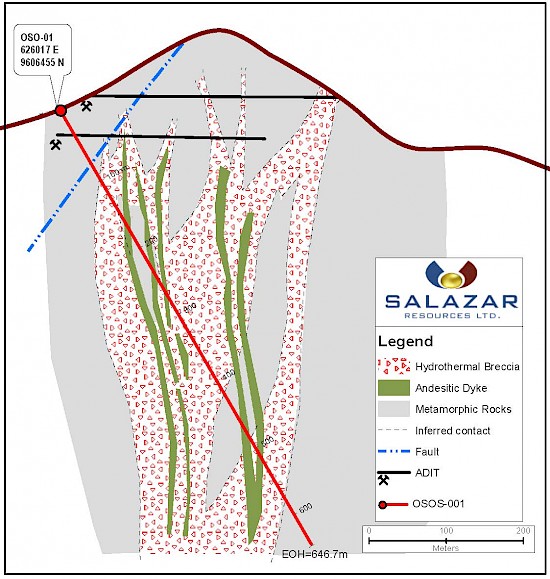
Source: Salazar Resources
Detailed logging and sampling of the whole hole is not yet complete, and a schematic cross-section is shown in Figure 3, above. In the upper portion of the section, two adits developed by artisanal miners are visible. Mapping of these underground workings revealed a similar suite of lithologies as those intersected in the drill hole. The miners target narrow high grade oxidised veins plus a margin of approximately 5 cm either side of the vein. Sampling of the workings indicated gold grades of 0.1 to 1.1 g/t gold in the breccias, diorite and metamorphic host rocks, rising to 2.4 to 14.3 g/t gold in narrow vein structures (see Fig. 4).
Figure 4. Map of artisanal adits near the location of OSO-01
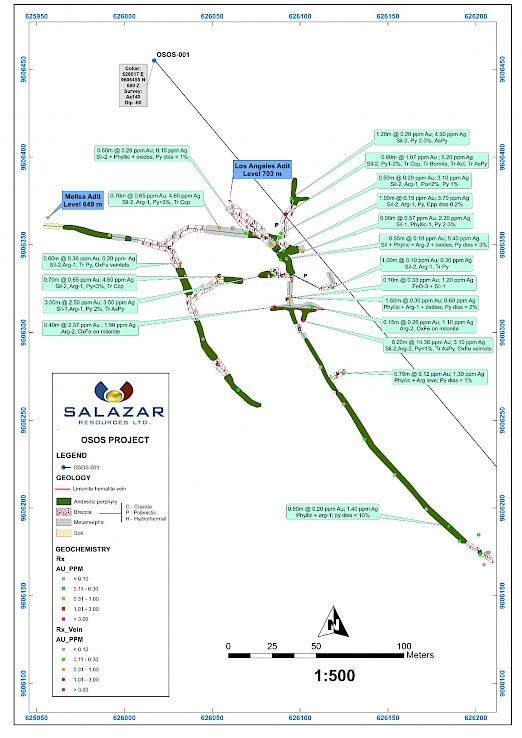
Source: Salazar Resources
The main breccia type is a quartz-tourmaline hydrothermal breccia with mosaic texture and largely monomictic angular clasts (see photo 3). The matrix is comprised of fine-grained tourmaline with pyrrhotite, chalcopyrite, pyrite and minor sericite. On the margins of these large quartz-tourmaline bodies, the breccia can exhibit a crackle-style texture. Volumetrically small but genetically important pebble dikes (photo 2) make up the third and final breccia type. These pebble dikes cross-cut all lithologies, range in width from 2 cm to 1.0 m, and exhibit subangular to rounded polymictic clasts and a fine matrix of tourmaline, pyrrhotite, pyrite and chalcopyrite. The pebble dikes are comprised of material brought up from depth and many of the clasts are rich in chalcopyrite, providing evidence of a mineralized porphyry at lower elevations. The breccias are silicified which contributes to the resistance to erosion and associated formation of hills as local topographic highs.
Photo 1. Metamorphic quartzite, depth 168 m | Photo 2. Pebble dike breccia, depth 178 m |
|
|
Description: Fine-Medium grained quartzite, dark green to gray-white color. Chlorite-illite alteration in the foliation and fine veinlets of pyrite and arsenopyrite and disseminated chalcopyrite (<0.5%) in banding | Description: Subangular-rounded polymictic clasts. Supported matrix of fine tourmaline, pyrrhotite, pyrite, and chalcopyrite |
Photo 3. Mosaic Breccia, depth 338 m | Photo 4. Porphyritic Diorite, depth 505 m |
|
|
Description: Hydrothermal Breccia mosaic texture, monomictic quartzite angular clasts. Fine tourmaline matrix with pyrrhotite, chalcopyrite, pyrite and +/- sericite | Description: Porphyritic texture, altered amphibole phenocrysts and corroded edges. Fine crystal matrix. Quartz-sericite-illite overprint with traces of remnant biotite-chlorite alteration. Disseminated sulphides pyrrhotite, pyrite and lesser chalcopyrite |
The largest continuous breccia body was intersected from 315 to 411 m, for an intersection length of 96 m. The hole ended at a depth of 647 m with the rig at its maximum capacity. Note that true widths of sub-vertical bodies are estimated to be approximately half of the reported down-hole intersection.
The diorite dikes (photo 4) have a porphyritic texture with amphibole phenocrysts, biotite formation and corroded edges amid a matrix of fine crystals suggesting an early potassic alteration phase. The dikes intersected in OSO-01 vary in thickness from 50 cm to 20 metres, often exhibit stockwork veining. All of the dikes are silicified and host disseminated pyrrhotite, pyrite and occasionally chalcopyrite. Chalcopyrite is more pervasive in the stockwork zones. A late stage phyllic over-print is visible, presenting as a quartz-sericite-illite assemblage, with trace biotite and chlorite.
The metamorphic host rocks (photo 1) intersected in OSO-01 are predominantly comprised of psammites with minor pelites, grouped together as metamorphic quartzites for simplicity. The quartzites are silicified and have disseminated fine-grained sulphides throughout.
Exploration Rationale
Salazar Resources is exploring for gold-copper, silica-saturated, alkalic porphyry-style deposits in the Cangrejos-Zaruma intrusive belt, which is well known for these types of deposits. Au-Cu alkalic porphyry deposits include Cangrejos just 8 km to the northeast of Osos, as well as international examples in Cadia, Australia; Bingham Canyon, USA; Andacollo, Chile; and Red Chris, Canada. All of these deposits have similar chemical affinities and host-rock provenance such as porphyry intrusive rocks that intrude volcanic and sedimentary packages as stocks, plugs, dikes, and dike swarms. Mineralization results from late-stage hydrothermal activity driven by remnant heat from the porphyry intrusion. Thermal gradients within these systems give rise to broadly concentric, although often complexly intermingled, zones of alteration and mineralization.
Deposit boundaries are typically determined by economic factors that outline the zones of mineralized material. The distribution of alteration and mineral facies are largely influenced by breccias, dikes, veins, and fracture systems which concentrate and control fluid flow.
Alkalic porphyry systems are typically high-grade porphyry-style deposits associated with small volume pipe-like intrusions that have surface expressions of only a few hundred square meters. These systems are increasingly being recognized as being of important economic significance. They include some of the world’s highest grade and largest porphyry-related gold resources.
Ongoing Work
OSO-01 is being logged in detail, and the entire hole is being prepared for assay. Results are expected approximately four weeks after the samples have been dispatched. Results will be reported once received, interpreted and validated. Meanwhile, OSO-02 has been started, collared at an elevation approximately 300 m lower than OSOS-02 (see Fig. 4). The hole is oriented towards the east aiming to test for a mineralized diorite intrusion that is visible in outcrop in creeks and is believed to be the source of the broad copper anomaly in the southern part of the area. OSO-02 intersected a porphyry diorite with quartz-sulphide stockwork veining, and disseminated sulphides at a depth of 75 m. The hole is currently at a depth of 400 m and still in mineralized porphyry diorite. The hole is planned to be 500 m but will continue at depth if still in mineralization.
Figure 5. Phase 1 drill plan, Los Osos, El Oro, Ecuador
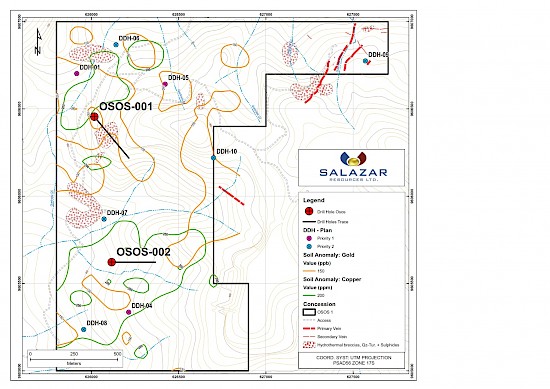
Source: Salazar Resources
QAQC
Salazar maintains a rigorous chain-of-custody and quality assurance/quality control program that includes the insertion of certified standard control samples and blanks, and re-analysis of samples with high levels (over limit) of gold, copper and zinc. All samples were analysed by Inspectorate Services Perú S.A.C. (Bureau Veritas), a certified ISO 17025:1999 and ISO 9001:2000 laboratory. The laboratory also maintains a QAQC program that includes insertion of blanks, standards and duplicate reanalysis of selected samples. Gold was analysed by fire assay – atomic absorption spectroscopy (FA-AAS). Silver, copper, zinc and other elements were analyzed by aqua regia extraction with an Inductively Coupled Plasma — Mass Spectroscopy (ICP-MS) finish.
Qualified Person
Kieran Downes, P. Geo., a Qualified Person as defined by National Instrument 43-101, has reviewed and verified the technical information provided in this release.
About Salazar
Salazar Resources (SRL.V) (CCG.F) is focused on creating value and positive change through discovery, exploration and development in Ecuador. The team has an unrivalled understanding of the geology in-country, and has played an integral role in the discovery of many of the major projects in Ecuador, including the two newest operating gold and copper mines.
Salazar Resources has a wholly-owned pipeline of copper-gold exploration projects across Ecuador with a strategy to make another commercial discovery and farm-out non-core assets. The Company actively engages with Ecuadorian communities and together with the Salazar family it co-founded The Salazar Foundation, an independent non-profit organisation dedicated to sustainable progress through economic development.
The Company already has carried interests in three projects. At its maiden discovery, Curipamba, Salazar Resources has a 25% stake fully carried through to production. A feasibility study is underway and a 2019 PEA generated a base case NPV(8%) of US$288 million. At two copper-gold porphyry projects, Pijili and Santiago, the Company has a 20% stake fully carried through to a construction decision.
(1)https://challengerex.com/wp-content/uploads/TechnicalPaperElGuyaboJRKConsulting4Mar18.pdf

